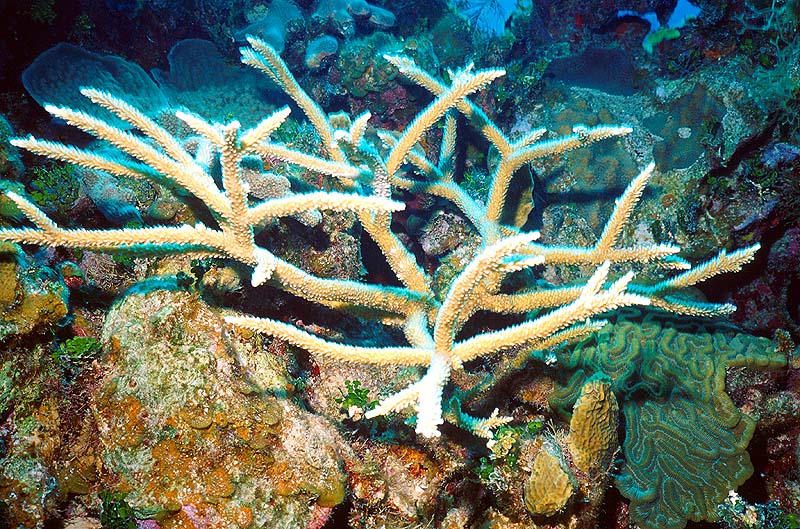
Volume 4 Number 3
Hurricanes and Tropical Reefs:
Staghorn Coral


Volume 4 Number 3
Hurricanes and Tropical Reefs:
Staghorn Coral

What happens to the tropical reef when there is a hurricane overhead? The answer is: not much. Most of the corals and sponges that are the building blocks of the reef are short and stout, and the waves of the hurricane simply flow around them. But there are two exceptions to this general rule.
The first exception is that some corals may be broken by the hurricane's waves. Some corals are very fragile. These corals build homes that are long branches of thin calcium-based rock. This picture shows one such fragile coral, called Staghorn Coral. Its name is appropriate, as the long, thin branches of this coral look a lot like a deer's antlers. Staghorn Coral is very fragile and easily broken. Curiously, Staghorn Coral is found in shallow water, exactly where the waves of the hurricane will cause the most damage. These fragile branches are often broken and scattered by the waves of a hurricane.
Scientists have realized that these corals are designed to be broken. That is, as the pieces are broken and scattered, the coral polyps that live on those pieces can survive. The surviving coral can start to build a new home where the piece comes to rest, helping the Staghorn Coral community to spread out across the reef. But this process takes centuries, as the corals only build their fragile home at the rate of about 1/4 of an inch each year. The branches of the Staghorn Coral in this picture were about 1 foot long, meaning this colony had been growing for about 50 years.
The second exception to the rule about hurricanes not causing much harm to the reef is that the sand near the reef will be stirred up and some of this sand will settle on top of the corals. But, no worry. Corals can push the sand away by excreting a mucus coating that carries the sand away from those animals. As long as there is not too much sand, the corals will survive.
This picture also shows a small Brain Coral. You can see the green grooves of this coral near the lower right corner of the picture. Also notice that the Staghorn Coral is growing near the top of this reef. You can see a little blue water in the distance over the top of this reef through the gaps between the corals at the top of this picture.
--------------------
e-ReefNews and embedded illustrations are
Copyright © 2002 ReefNews, Inc.
ReefNews ® is a registered trademark of ReefNews, Inc.